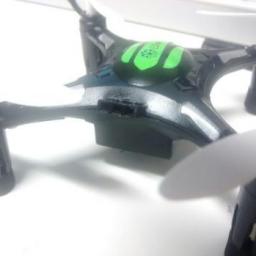
Since now you're going to either
register your drone or have to be flying your indoors anyway in the USA, you might as well celebrate the one freedom you still have the freedom to re-flash the firmware with open source! The Eachine H8 is a typical-looking mini-quadcopter of the kind that sell for under $20. Inside, the whole show is powered by an ARM Cortex-M3 processor, with the programming pins easily visible. Who could resist? Garagedrone takes you through
a step-by-step guide to re-flashing the device with a custom firmware to enable acrobatic mode, or simply to tweak the throttle-to-gyro mapping for the quad. The firmware author silverxxx from RCGroups.com even got the
code up on GitHub if you're interested in taking a peek. Next step, Skynet!
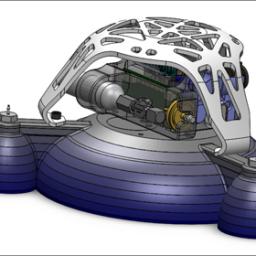
Traditional industrial robots are rigid as well as fast, precise, and powerful. Their speed and accuracy come at the cost of complexity and can often pose a danger to humans who get too close. Soft robots are adaptable and resilient but slow, difficult to fabricate, and challenging to make autonomous because most motors, pumps, batteries, sensors, and microcontrollers are rigid. But what if you could combine the autonomy and speed of a rigid robot with the adaptability and resiliency of a soft robot, and do so relatively cheaply and quickly?
http://wyss.harvard.edu/viewpressrelease/207/a-jump-for-softbodied-robots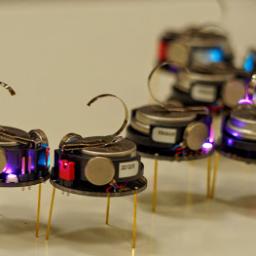
Researchers at Harvard university had demonstrated a self-organizing swarm which was formed by one thousand little robots known as "Kilobots". The robots begin to blink at one another and then gradually arrange themselves into a five-pointed star, once after a computer scientist gave a command for forming a sea Star shape to 1,024 little bots simultaneously via an infrared light. Just as single cells can assemble into complex multicellular organisms, the individual Kilobots can follow simple rules to autonomously assemble into predetermined shapes.
http://www.eecs.harvard.edu/ssr/projects/progSA/kilobot.html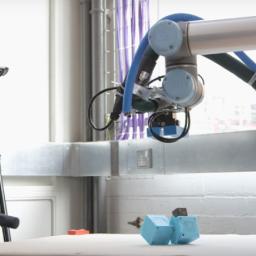
Researchers have observed the process of evolution by natural selection at work in robots, by constructing a 'mother' robot that can design, build and test its own 'children', and then use the results to improve the performance of the next generation, without relying on computer simulation or human intervention.
Researchers led by the University of Cambridge have built a mother robot that can independently build its own children and test which one does best; and then use the results to inform the design of the next generation, so that preferential traits are passed down from one generation to the next.
Without any human intervention or computer simulation beyond the initial command to build a robot capable of movement, the mother created children constructed of between one and five plastic cubes with a small motor inside.
Full article:
http://robotglobe.org/a-mother-robot-that-can-design-build-and-test-its-own-children/3D printing Technology is growing very fast upto the level of printing a building itself. A professor is working on technology named as Contour Crafting which can print an entire 2,500 sqft house in 20 hours.
Behrokh Khoshnevis is a professor of Industrial & Systems Engineering and is the Director of Manufacturing Engineering Graduate Program at the University of Southern California (USC). He is active in CAD/CAM, robotics and mechatronics related related research projects. He was able to make a printhead that can extrude wet cement in such a way that the cement is able to keep its form as each successive layer is printed.
Using the Contour Crafting (CC) developed by Behrokh Khoshnevis , a single house or a colony of houses, each with possibly a different design, may be automatically constructed in a single run, embedded in each house all the conduits for electrical, plumbing and air-conditioning.
The professor believes that his technology would make the construction of efficient buildings so cheap and efficient that we could print houses for Millions of poor people living in slums across the world. And, this kind of building process will avoid the killings and injuries related to construction accidents.
http://3dprinting.com/news/future-talk-3d-printing-entire-house-less-20-hours/Combining biological components, such as cells and tissues, with soft robotics can enable the fabrication of biological machines with the ability to sense, process signals, and produce force. Engineers at the University of Illinois are working on developing a Bio-Robot which can be produced easily by using 3D printing technology. They developed similar bio-bots few years back, but that time they used heart cells. Now they find a way to use muscle cells to gain more control. The frequency of the electric field determines the speed of this bio-bot.
https://www.youtube.com/watch?v=F6SUbHn4yg4&list=PLK2ccNIJVPpC7ny_lpawhue_k3pfwqTQ2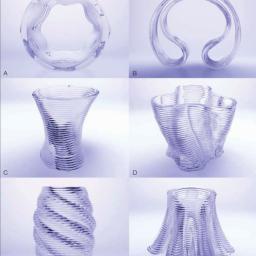
Glass was first created in Mesopotamia and Ancient Egypt 4,500 years ago.
Glass can be molded, formed, blown, plated or sintered; its formal qualities are closely tied to techniques used for its formation.
Now We can 3D Print the Glass. i-e Glass can be used as Ink in 3D printers instead of plastics
Researchers at the Massachusetts Institute of Technology (MIT) unveiled a first of its kind optically transparent glass printing process called G3DP.
G3DP is an additive manufacturing platform designed to print optically transparent glass.
https://www.youtube.com/watch?v=_Lx2loldi6o&list=PLK2ccNIJVPpB_XqWWq_oaZGIDzmKiSkYchttp://3dprint.com/90748/g3dp-glass-3d-print/Back in 1950, a farmer would have been able to grow around 2,500 kilograms of wheat per hectare of cropland. Today, that figure has more than tripled. Advances in plant breeding and technical innovations will continue to be necessary in order to feed the growing global population. This is where Bosch's agricultural robot "Bonirob" can play a part.
According to estimates, agricultural yields need to increase by three percent a year to keep up with population growth. Along with innovative agricultural technology and improved crop protection, more efficient plant breeding will play a particularly important role.
In this area, Bonirob automates and speeds up analysis. The robot, which is approximately the size of a compact car, uses video- and lidar-based positioning as well as satellite navigation to find its way around the fields. It knows its position to the nearest centimeter. It also helps minimize the environmental impact of crop farming.
Read more...
https://www.youtube.com/watch?v=n_KM5tPtz-U&list=PLK2ccNIJVPpB_XqWWq_oaZGIDzmKiSkYc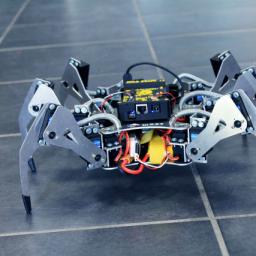
Erle Robotics has launched an Indiegogo crowdfunding campaign for what it claims is the "first smart robotic spider powered by Snappy Ubuntu Core". Developers can create apps using the open source Robot Operating System (ROS), and distribute/sell them through Erle Robotics' apps store. The six-legged "spider" weighs just over 2 kilograms (4.4lbs) and has 45 minutes of autonomy. Powering the system is a 900MHz quad-core ARM Cortex-A7 CPU with 1 GB of RAM; the Erle-Spider comes with a
gravity sensor, gyroscope, digital compass, pressure sensor, and temperature sensor. "This robot provides connectivity through Bluetooth, Wi-Fi, 3G and 4G networks, etc. then the people can control it through their mobile phones, joysticks, laptops, tablets, etc. and this can even act as a hot spot for Wi-Fi".
Options include a basic kit for about 250 ($400), and an assembled version for around 420 ($640). But oddly, there doesn't seem to be an option to add two extra legs to convert this "spider" from a hexapod into an actual arachnid.
The article comes out of the Australian press, but unless there's something truly unique about the Australian job market, it's almost certainly true elsewhere as well:
a recent study shows more than half of young Australians are receiving college education to persue careers that will soon no longer exist. Thank robotics, industry consolidation, and the nature of the markets for the shrinking number of ways you will some day be able to earn a living.
There's a flip side to the debate, of course: there are certainly new things coming that haven't even been invented yet, that will provide job opportunities. But the trick is positioning yourself appropriately to take advantage of the new chances.
The not-for-profit group, which works with young Australians to create social change, says the national curriculum is stuck in the past and digital literacy, in particular, needs to be boosted. Foundation chief executive Jan Owen says young people are not prepared for a working life that could include five career changes and an average of 17 different jobs.
She says today's students will be affected by three key economic drivers: automation, globalisation and collaboration. "Many jobs and careers are disappearing because of automation," Ms Owen said. "The second driver is globalisation - a lot of different jobs that we're importing and exporting. And then thirdly collaboration which is all about this new sharing economy."
How does one future-proof his/her life and career?
 Since now you're going to either register your drone or have to be flying your indoors anyway in the USA, you might as well celebrate the one freedom you still have the freedom to re-flash the firmware with open source! The Eachine H8 is a typical-looking mini-quadcopter of the kind that sell for under $20. Inside, the whole show is powered by an ARM Cortex-M3 processor, with the programming pins easily visible. Who could resist? Garagedrone takes you through a step-by-step guide to re-flashing the device with a custom firmware to enable acrobatic mode, or simply to tweak the throttle-to-gyro mapping for the quad. The firmware author silverxxx from RCGroups.com even got the code up on GitHub if you're interested in taking a peek. Next step, Skynet!
Since now you're going to either register your drone or have to be flying your indoors anyway in the USA, you might as well celebrate the one freedom you still have the freedom to re-flash the firmware with open source! The Eachine H8 is a typical-looking mini-quadcopter of the kind that sell for under $20. Inside, the whole show is powered by an ARM Cortex-M3 processor, with the programming pins easily visible. Who could resist? Garagedrone takes you through a step-by-step guide to re-flashing the device with a custom firmware to enable acrobatic mode, or simply to tweak the throttle-to-gyro mapping for the quad. The firmware author silverxxx from RCGroups.com even got the code up on GitHub if you're interested in taking a peek. Next step, Skynet!



